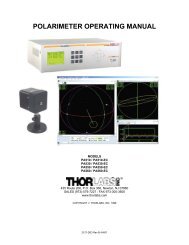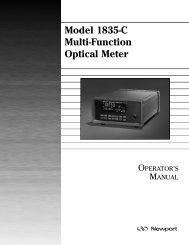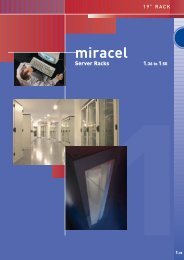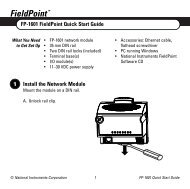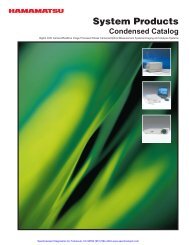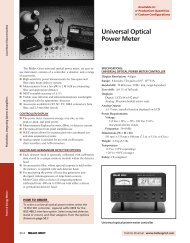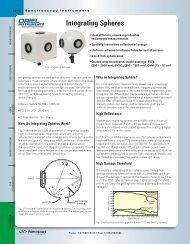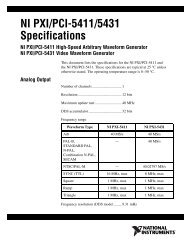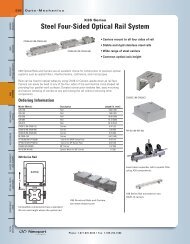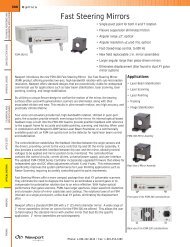(8.5x11) 6000 Manual Cover - Newport Corporation
(8.5x11) 6000 Manual Cover - Newport Corporation
(8.5x11) 6000 Manual Cover - Newport Corporation
You also want an ePaper? Increase the reach of your titles
YUMPU automatically turns print PDFs into web optimized ePapers that Google loves.
3.6 Measurement Considerations<br />
This section describes detector characteristics, optical and electrical considerations,<br />
and environmental influences on optical measurements. In general,<br />
measurement accuracy is limited by the accuracy of the detector calibration.<br />
Accurate measurements, however, are also dependent upon proper set-up,<br />
control of temperature and illumination conditions and understanding the<br />
factors that affect optical measurements.<br />
3.6.1 Detector Calibration and Accuracy<br />
<strong>Newport</strong> <strong>Corporation</strong> calibrates its detectors using secondary standards<br />
directly traceable to the United States National Institute of Science and<br />
Technology (NIST) or to Great Britain’s National Physical Laboratory (NPL).<br />
The details and accuracy of the calibration procedure vary with each detector<br />
model but a detailed description of the calibration results is supplied with<br />
each individually calibrated detector. In general, detector calibration accuracy<br />
varies from 2% to 5% in absolute terms and varies with wavelength.<br />
Each detector will also have some variation in response over its surface.<br />
Therefore, for the most reproducible measurements, light should illuminate<br />
the detector as uniformly as possible over as large an area as practical.<br />
CAUTION<br />
Avoid focusing a light source onto the detector surface. Inaccurate<br />
readings and possible detector damage may result. Consult the detector<br />
manual for saturation or damage thresholds.<br />
NIST traceability requires that detectors be recalibrated on one year intervals.<br />
As individual detector responses change with time, especially in the<br />
ultraviolet, recalibration is necessary to assure confidence in the accuracy of<br />
the measurement. For the most reproducible measurements, the same<br />
detector should always be used for measurements which are to be directly<br />
compared.<br />
3.6.2 Quantum Detector Temperature Effects<br />
<strong>Newport</strong> Low-Power semiconductor detectors, are affected by temperature.<br />
At long wavelengths, quantum detectors typically lose sensitivity with increasing<br />
temperature. Additionally, detector dark current increases exponentially<br />
with temperature.<br />
Observed dark current is often dominated by the interaction between the<br />
detector and a meter’s amplifier and is typically larger than the theoretical<br />
dark current limit. Silicon detectors are inherently quieter than germanium<br />
detectors due to their higher internal resistance and lower capacitance. The<br />
noise or drift in the dark current sets a lower bound on the measurement<br />
resolution which can be achieved with any given detector. Cooling a detector<br />
significantly lowers its dark current and dark current noise.<br />
The observed dark currents can also be zeroed at any moment via the ZERO<br />
function. Since dark currents drift with temperature, the ZERO should be<br />
adjusted just prior to taking any measurements. If the detector temperature<br />
is constant, sensitivity changes and dark current drifts are significantly<br />
reduced.<br />
28



